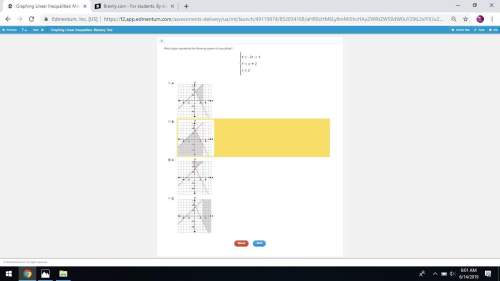
Mathematics, 16.10.2019 06:00 oktacos
Acustomer has six (6) $1 bills, three (3) $5 bills, four (4) $10 bills, seven (7) quarters, ten (10) dimes, seven (7) nickels, and nine (9) pennies. the customer buys a pair of shoes for $49.86. based on the combination of bills and coins the customer has, what are the least number of bills and coins the customer can give the cashier in order to buy the shoes for the exact amount and not require any change back? 8 bills, 5 coins 8 bills, 6 coins 9 bills, 5 coins 9 bills, 8 coins 10 bills, 7 coins

Answers: 2


Another question on Mathematics

Mathematics, 21.06.2019 18:00
Each month, a shopkeeper spends 5x + 14 dollars on rent and electricity. if he spends 3x−5 dollars on rent, how much does he spend on electricity? for which value(s) of x is the amount the shopkeeper spends on electricity less than $100? explain how you found the value(s).
Answers: 2

Mathematics, 21.06.2019 19:30
What is the result of adding the system of equations? 2x+y=4 3x-y=6
Answers: 2

Mathematics, 21.06.2019 20:30
Find the magnitude, correct to two decimal places, made by each of the following with positive direction of the x axis a) y= x the answer is 45° but i don’t know how
Answers: 2

Mathematics, 22.06.2019 00:00
Which is a logical conclusion based on the given information? a. figure abcd is a rhombus by the definition of a rhombus. b. segment ac is congruent to segment dc by cpctc. c. angle acb is congruent to angle adc by the angle-side-angle theorem. d. triangle acd is congruent to triangle cab by the hypotenuse-leg theorem.
Answers: 1
You know the right answer?
Acustomer has six (6) $1 bills, three (3) $5 bills, four (4) $10 bills, seven (7) quarters, ten (10)...
Questions


Mathematics, 12.02.2020 06:01

English, 12.02.2020 06:01

History, 12.02.2020 06:01

Chemistry, 12.02.2020 06:01





Chemistry, 12.02.2020 06:01


Mathematics, 12.02.2020 06:01







History, 12.02.2020 06:01




